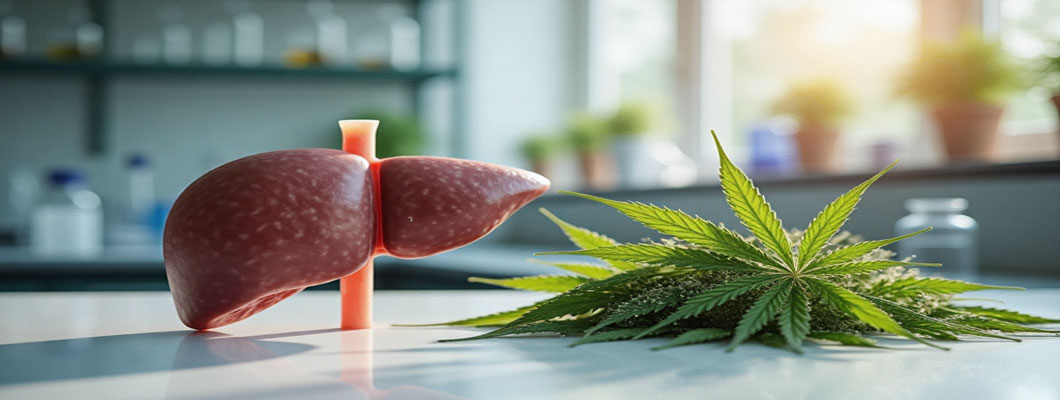
Recently, Cancer Cell International published a comprehensive review examining the potential of cannabidiol (CBD) as a treatment for liver cancer. Drawing on evidence from 16 preclinical studies, the review systematically analyzes the multi-target mechanisms of CBD in hepatocellular carcinoma (HCC), including inducing apoptosis, regulating autophagy, inhibiting metastasis, and modulating the tumor microenvironment (TME). Here’s a closer look at the findings and what they could mean for future liver cancer therapies.
The Potential of CBD in Liver Cancer Treatment: Mechanisms and Evidence
Hepatocellular carcinoma (HCC) is one of the leading causes of cancer-related death worldwide, with a five-year survival rate that remains low due to late diagnosis and treatment resistance. Recent research has shown that cannabidiol (CBD), a non-psychoactive component of the cannabinoid family, offers new perspectives for HCC treatment through its unique multi-pathway antitumor mechanisms.
Given the poor prognosis and limited treatment options for HCC, CBD has become a focus of research thanks to its multi-target antitumor properties. This article comprehensively analyzes 16 studies (10 in vitro experiments, 4 animal studies, 2 clinical studies) to reveal the mechanisms of CBD and the challenges of clinical translation.
I. Key Evidence of Direct Antitumor Mechanisms
1. Inducing Apoptosis and Pyroptosis
PPARγ-mediated mitochondrial apoptosis: Guindé et al. (2009) found that the synthetic cannabinoid WIN 55,212-2 (a CBD analog) activated PPARγ in HepG2 cells, upregulated the pro-apoptotic protein Bax, downregulated Bcl-2, induced mitochondrial membrane potential collapse, and activated caspases.
GSDME-dependent pyroptosis (programmed inflammatory death): Shangguan et al. (2021) first confirmed that CBD triggered inflammatory cell death in liver cancer cells (HepG2, Huh7) and mouse models by caspase-3–mediated cleavage of GSDME, while also inhibiting the ATF4-IGFBP1-Akt pathway critical for tumor glucose metabolism.
2. Inhibiting Metastasis and Invasion
Blocking matrix metalloproteinases (MMPs): Pourkhalili et al. (2013) demonstrated that cannabinoid receptor agonists ACEA and CB65 significantly downregulated MMP-2/MMP-9 expression (at 20 nM) in HepG2 cells, suppressing cancer cell invasion.
Regulating EMT: Animal studies showed that CBD inhibits the epithelial–mesenchymal transition (EMT) pathway, reducing the risk of liver cancer metastasis.
3. Bidirectional Modulation of Cannabinoid Receptors
CB1 pro-tumor vs. CB2 anti-tumor: Suk et al. (2016) reported in a DEN-induced mouse liver cancer model that CB1 activation promoted tumor growth via FOXM1 and IDO2, whereas CB2 activation recruited anti-tumor T cells to inhibit progression.
Validation in human tissue: Yang et al. (2019) analyzed tissues from 67 HCC patients and found CB1 was downregulated and CB2 upregulated in tumors, along with disrupted ceramide metabolism, suggesting therapeutic potential of receptor-targeting strategies.
II. Breakthrough Findings in Chemotherapy Synergy
4. Sensitizing Sorafenib/Cabozantinib
ER Stress and p53 Activation: Jeon et al. (2023) demonstrated that CBD (0–100 μM) combined with cabozantinib in HepG2/Hep3B cells significantly enhanced apoptosis by inducing endoplasmic reticulum (ER) stress and p53 phosphorylation, independent of classical apoptosis proteins (Bax/Bcl-2).
Overcoming Drug Resistance: Preclinical studies suggest that CBD may inhibit multidrug resistance proteins (P-gp, BCRP), increasing intracellular accumulation of chemotherapeutic agents, though further validation in liver cancer models is needed.
5. Enhancing TRAIL Efficacy
Pelletier et al. (2010) found that synthetic cannabinoid WIN combined with TRAIL (tumor necrosis factor-related apoptosis-inducing ligand) reversed TRAIL resistance and induced synergistic apoptosis in HepG2 cells via activation of the CHOP-DR5 axis.
III. Clinical Translation Barriers and Solutions
6. Hepatotoxicity Risk
High doses of CBD (>20 mg/kg/day) can elevate liver enzymes (ALT/AST), and monitoring is especially necessary in patients with impaired liver function.
7. Drug Interactions
CBD is metabolized by liver enzymes CYP3A4/CYP2C19, which may increase the blood concentration of co-administered drugs (e.g., sorafenib).
8. Delivery System Innovation
Lipid-based nanocarriers can improve CBD’s low oral bioavailability and rapid metabolism.
IV. Conclusion
CBD, through its multifaceted antitumor activities — including induction of apoptosis and pyroptosis, regulation of autophagy, inhibition of metastasis, and disruption of tumor-supportive signaling pathways such as PI3K/Akt/mTOR — has emerged as a promising therapeutic agent for HCC. Beyond interactions with classical cannabinoid receptors, CBD also targets alternative molecular pathways such as TRPV1 and PPARγ, broadening its therapeutic relevance.
Importantly, CBD enhances the efficacy of chemotherapeutic agents like sorafenib and cabozantinib by promoting ER stress and p53 activation, suggesting its potential role as a chemosensitizer. Preliminary evidence also indicates that CBD may counteract multidrug resistance by modulating efflux transporters (P-glycoprotein, BCRP), although this requires further validation in HCC models.
Despite these promising effects, concerns regarding hepatotoxicity and drug–drug interactions warrant careful clinical consideration. CBD metabolism via hepatic cytochrome P450 enzymes may interfere with standard anticancer therapies, and its hepatic safety profile must be closely monitored.
Overall, while preclinical findings strongly support the therapeutic potential of CBD in hepatocellular carcinoma, robust clinical trials are urgently needed to confirm its efficacy, safety, optimal dosing strategies, and long-term outcomes. If validated, CBD could represent an innovative approach to HCC management.

Leave a Comment